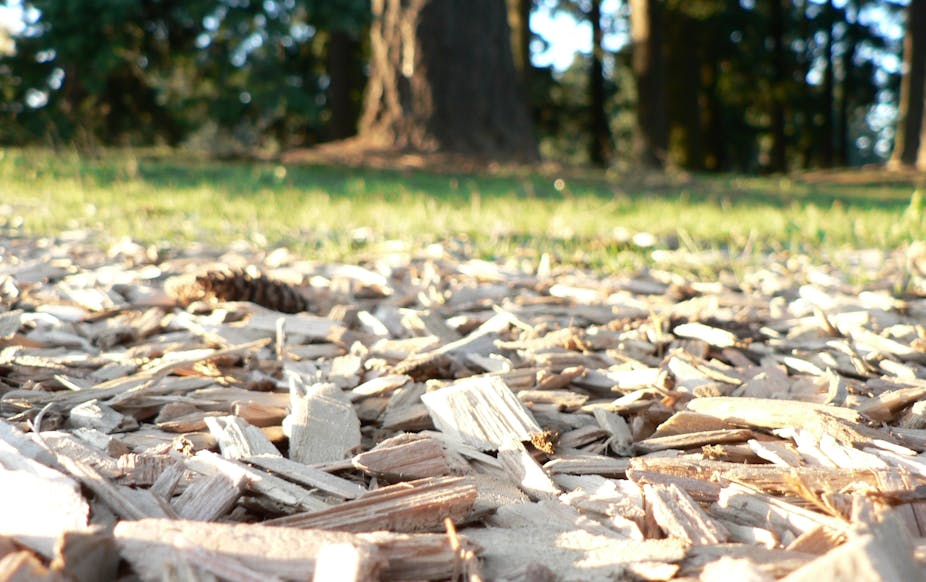One of the byproducts of the haggling over the new, scaled-back Renewable Energy Target is a renewed focus on woodchips, with the federal government’s draft legislation seeking to include wood from native forests as a certified source of renewable energy.
Forests produce a wealth of goods and services, but some of these goods are now being labelled as bad. Opponents of issuing renewable energy certificates to woodchip burning, such as The Australia Institute, point out that fuel wood and woodchips expand the commercial pressure on forests, while directing investment away from competing renewable energy industries like wind and solar power.
There is also a visceral belief in some quarters that cutting down something as big as a tree to make a product as small as a woodchip cannot possibly be a smart strategy. But woodchip production isn’t all bad – they can be used to make a host of wood products that are greener than the alternatives, and can be harvested in ways that can actually benefit forests.
Seeing the wood for the trees
There is no doubt that selling woodchips into a local or global market would increase the commercial viability of forest operations. But forestry operations that produce sawlogs would not be the only enterprise that benefits. Fire hazard reduction operations could also become largely self-funding if the hazardous material could be sold as chip or fuel wood.
After several disastrous fire seasons, United States taxpayers are funding a US$400 million hazard-reduction program that uses tree removal as well as planned burning. Repurposing or selling the cleared material could recoup an estimated 40% of the cost of implementing the program.
Removing selected trees can have other benefits too. Ecological thinning - in which neighbouring trees are removed to help conserve selected tree species - can enhance the overall health of a forest and make it more resilient to drought and other stresses. Thinning will also promote growth on the remaining trees, allowing them to achieve more quickly the size needed to support hollows for arboreal mammals. These operations are work-intensive and expensive, but again the costs could be offset by the sale of woodchips or fuel wood.
In Canada, the mountain pine beetle has devastated thousands of hectares of forest. The Canadian government now provides substantial funding to First Nations, communities and school districts to help control this devastating outbreak by fuel management and hazard tree removal in areas that were previously infested. Much of the cost of these programs is recovered by selling the killed timber as solid, chip or fuel wood.
The wood that could
Forest goods can also be used to create building materials that can compete directly against steel or concrete. Engineered wood, also called “composite” or “manufactured” wood, can be made from solid wood, woodchips, or even waste sawdust, and offers an alternative to raw timber products.
True, these products drive commercial forestry, just like traditional timber does. But full life-cycle analyses show that these solutions can be environmentally and economically more profitable than the steel and concrete alternatives.
Similarly, fuel wood and other bioenergy products from forests can substitute for brown or black coal. Pelletised, gasified and liquified woodchips can be burned in the absence of wind or sunshine, with minimal net pollution, to produce heat for warming homes, generating steam for electricity production or even powering motor vehicles. Wood chips can even be made into flexible high-capacity batteries
In the past, one of the major problems with bioenergy was scale – plants needed to be large with extensive feed stock to be profitable. But improvements in technology mean the minimum size of efficient bioenergy plants has been substantially reduced. Small industries can install gasifiers to meet their own energy requirements and potentially sell the excess power into the market. Similarly, mobile wood-chippers could follow thinning operations in a forest to supply small pelletising or liquefying plants.
Of course, electricity from biofuels competes directly with wind and solar power, as well as with coal-fired power, but there are numerous niches for alternatives to coal and oil. Wind farms, for instance, have an advantage in areas where there is no existing forest and where water-use policies restrict the establishment of new plantations.
Hail the humble woodchip
An individual woodchip looks too small to be really valuable. However, the structure and chemistry of that chip is truly remarkable, because it can be made into a wealth of products, from pharmaceuticals to skyscrapers! These chips contain complex long molecules, rich with oxygen which form sugars and starches. These, in turn, can be made into glues, alcohols, solvents, and a host of drugs, polymers and dyes. These can be reconfigured to produce everything from biodegradable bottles and other packaging, to computer chips.
Indeed, arguably the most effective way of keep biomass burning out of the renewable energy market might be to find even higher-value uses for woodchips, and thus price them out of the energy sector (although that strategy would admittedly not do much to reduce commercial uses of forests).
The biggest problem with woodchips is not their relative worthlessness, but the development of industries near the forest that can utilise its many strengths from energy production through to manufacturing. The challenge will be to make woodchip-based industries profitable at sizes that contribute sustainably to ecological thinning and fire-hazard reduction in our native forests, without damaging the rural landscape.
That way, the humble woodchip could deliver both industrial and environmental wins.

